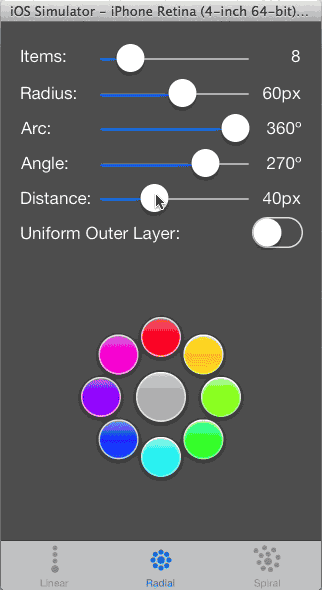DLWidgetMenu is a versatile solution for displaying widget menus and can easily be extended with custom layouts and/or animations.
DLWidgetMenu comes with three built-in layouts:
DLWMLinearLayoutDLWMRadialLayoutDLWMSpiralLayout
DLWidgetMenu uses iOS7's spring animations (DLWMSpringMenuAnimator) by default, but can easily be provided with your own custom animations as well (by subclassing DLWMMenuAnimator).
DLWidgetMenu observes its menu items for these gesture recognizer events:
- single tap
- double tap
- long press
- pan
- pinch
and forwards them directly to its delegate.
None of these events make DLWidgetMenu do anything by default.
The menu (by default) doesn't even open, when you tap it!
And it shouldn't.
DLWidgetMenu was specifically designed to keep you in full control over its behaviour. All it does is animating and layouting its menu items. Keeping you in total charge of what to do and when.
Assuming you do want DLWidgetMenu to open when single-tapped, all you need to do is implement this in your DLWMMenuDelegate:
- (void)receivedSingleTap:(UITapGestureRecognizer *)recognizer onItem:(DLWMMenuItem *)item inMenu:(DLWMMenu *)menu {
if ([menu isClosedOrClosing]) {
[menu open];
} else if ([menu isOpenedOrOpening]) {
if (item == menu.mainItem) {
[menu close];
} else {
[menu closeWithSpecialAnimator:[[DLWMSelectionMenuAnimator alloc] init] forItem:item];
}
}
}As you can see the delegate makes DLWidgetMenu use a custom animator for the tapped menu item by calling:
[menu closeWithSpecialAnimator:[[DLWMSelectionMenuAnimator alloc] init] forItem:item];(The built-in DLWMSelectionMenuAnimator applies a scale-up in combination with a fade-out.)
Don't want that? Fine, just call [menu close]; then.
Okay, tapping is pretty standard stuff, right? Nothing too fancy. So how about moving a menu around using a pan gesture? Piece of cake:
- (void)receivedPan:(UIPanGestureRecognizer *)recognizer onItem:(DLWMMenuItem *)item inMenu:(DLWMMenu *)menu {
// NSLog(@"%s", __FUNCTION__);
if (item == menu.mainItem) {
[menu moveTo:[recognizer locationInView:menu.superview] animated:NO];
}
}It's worth mentioning here that one should usually prefer [menu moveTo:… animated:…]; over menu.center = …; (while the menu is open, that is).
The reason for this is that DLWidgetMenu shrinks to just wrap its main item when closed and stretches to fit its superview when opened (in order to catch tap events outside its menu items). Just enable the debugging-mode (menu.debuggingEnabled = YES;) and you should get an idea of what this means.
Just copy the files in "DLWidgetMenu/Classes/..." into your project.
Alternatively you can install DLWidgetMenu into your project with CocoaPods.
Just add it to your Podfile: pod 'DLWidgetMenu'
DLWidgetMenu contains a demo app giving you a quick overview of all three included layouts.
DLWidgetMenu uses automatic reference counting (ARC).
None.
Vincent Esche (@regexident)
DLWidgetMenu is available under a modified BSD-3 clause license with the additional requirement of attribution. See the LICENSE file for more info.
